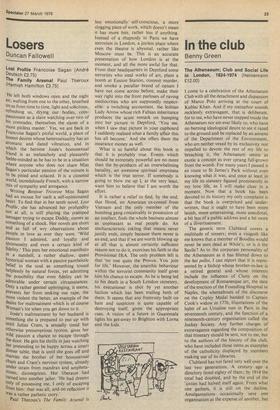In the club
Benny Green
The Athenaeum; Club and Social Life in London, 1824-1974 (Heinemann E12.00) I come to a celebration of the Athenaeum Club with all the detachment and dispassion of Marco Polo arriving at the court of Kublai Khan. And if my metaphor sounds recklessly extravagant, that is deliberate, for to me, who have never stepped inside the Athenaeum nor am ever likely to, who have no burning ideological desire to see it razed to the ground and be replaced by an annexe of the Department of the Environment, who am neither vexed by its exclusivity nor impelled to devote the rest of my life to breaching it, the Athenaeum seems as exotic a concept as ever sprang full-grown from the womb. For many years I passed it en route to St James's Park without even knowing what it was, and once at least in my life its statuary figured prominently in my love life, as I will make clear in a moment. Now that a book has been devoted to its history my only complaint is that the book is overpriced and underwritten, that it ought to have been more lavish, more entertaining, more anecdotal, a bit less of a public address and a bit more of a divertissement.
The generic term Clubland covers a multitude of sinners; even a visigoth like me knows that a member of Boodles would never be seen dead at White's, or is it the Savile? As to the corporate personality of the Athenaeum as it has filtered down to the hoi polloi, I can report that it is represented by a bishop whose brother-in-law is a retired general and whose interests include the influence of Cluny on the development of Romanesque art, the date of the erection of the Foundling Hospital in Naples, the whereabouts of the discourse on the Copley Medal handed to Captain Cook's widow in 1776, illustrations of the habit of an Ursuline nun in Paris in the seventeenth century, and the function of a nineteenth-century organisation called the Jockey Society. Any further charges of extravagance regarding the composition of that itinerary should be sent, not to me, but to the authors of the history of the club, who have included those items as examples of the catholicity displayed by members making use of its libraries.
Clubland has not fared very well over the last two generations. A century ago a directory listed eighty of them; by 1914 the total had doubled, and by the end of the 'sixties had halved itself again. From what one gathers, it is still on the decline. Amalgamations occasionally save one organisation at the expense of another, but


































 Previous page
Previous page